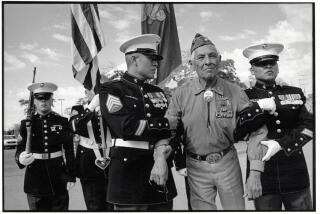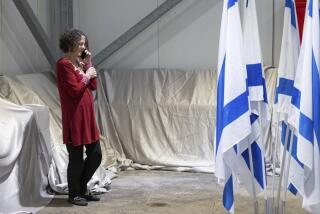Yuki Llewellyn, a child of Manzanar whose image touched America, dies at 80
Sitting on a suitcase in Union Station, waiting to be hauled off to Manzanar with her mom, Yuki Okinaga Hayakawa was the very picture of uncertainty.
The look on the 2-year-old’s face is difficult to read, though dread comes to mind. She clutches a tiny purse in one hand and a half-eaten apple in the other. Ahead lay years behind barbed wire fencing in the Owens Valley along with thousands of other people of Japanese descent as America was pulled into World War II.
The photograph is hard to miss in the visitors center at the Manzanar National Historic Site and seems to beg the same questions from visitors: Who was this child? What happened to her?
Yuki and her mother were among the first to arrive and the last to leave Manzanar when the war ended, when they moved to Cleveland to start anew. She was taunted and subjected to racial slurs at school but remained remarkably buoyant. She won a college scholarship, earned a bachelor’s degree and ultimately a master’s in fine arts. She married, had a son, became a college administrator, wrote a cookbook and developed a dry sense of humor with spot-on timing when she told a joke, which was frequently.
Though the photo of her sitting in the train station became iconic — appearing on book covers, billboards and displayed at exhibits — her death on March 8 was little noticed. The COVID-19 pandemic prevented her family from having a memorial, and no public announcement was made. Unwilling to let her death go unrecognized, a family friend from Long Beach reached out to the Los Angeles Times.
Yuki Okinaga Hayakawa Llewellyn was 80 and had been ill for some time, her friend Carol Norcross said.
As with many Japanese Americans who were uprooted, imprisoned and left with an uncertain future, the memories of Manzanar were seared into Llewellyn’s soul. She did research on the incarceration camp, wrestled with what it meant to be a Japanese American and shuddered at the thought that such a thing might someday happen again.
“People you elect into power are the ones that are able to do things like that,” she told author and photographer Paul Kitagaki Jr. in his book “Behind Barbed Wire.” “But I don’t see the numbers showing that the young people are voting, and that saddens me. That’s the only way you can control what’s going to happen.”
In 2005, Llewellyn returned to Manzanar for the first time since she was a child. For years the prison camp had been left to the elements and the scavengers, until all that remained were a pair of sentry towers and a cemetery. Manzanar was eventually proclaimed a national historic site, and a visitors center and other features were added. It is now both a destination and an enduring emblem of racial hysteria.
Llewellyn was initially torn about reopening the old wounds of Manzanar, said Norcross, who drove her friend up Highway 395 for the visit. But when she got there, there was little left of what she remembered.
“There was nothing for her to really hang her thoughts or emotions on,” Norcross said. “There was nothing to say, ‘I was here.’”
In a commentary published in the Pacific Citizen in 2005, Llewellyn said she gathered some sand, an old nail from the barracks and a random piece of bamboo as mementos, tucking them carefully into a sandwich bag. As she stood there, she said she finally understood why her mother had no interest in revisiting Manzanar.
“As an adult, it would have been hell on Earth,” she wrote. “I was lucky to have been a child — a young child at that — I didn’t know what it was like not to be incarcerated.”
Her son David said as word got out that she was visiting Manzanar, people began coming up to her and apologizing for what the country had done. Some hugged her.
“Many were probably just kids like her at the time who couldn’t believe that we had done such a shameful thing,” he said.
Llewellyn met her husband, Don, while working on her thesis at Tulane University in New Orleans. The two later worked together on a theatrical production of Akira Kurosawa’s psychological thriller “Rashomon.” They later divorced but remained friends.
At the University of Illinois at Urbana-Champaign, where she rose from being a secretary to assistant dean of students, Llewellyn explored her ancestry and her own past. She brought noted Japanese Americans to speak at the university, celebrated when the campus opened an Asian American cultural center, and spoke out about Manzanar and Executive Order 9066, which set the wheels in motion for the creation of the camps following the bombing at Pearl Harbor.
In her research, Llewellyn discovered that her father, who had left her mother before the two were hurried off to Manzanar, was also detained at the camp. Among the thousands of other prisoners at the camp, she had never seen him.
Later in life, when she tried to find him, she discovered he was already dead.
At Manzanar, Llewellyn gazed at the childhood photo and the memories came tumbling back.
“The happiest moment is the fact that I did discover something that I have been looking for all my life,” she wrote in the commentary. “The closure will be if I can write about it.”
Llewellyn is survived by her son, her daughter-in-law and three grandchildren.
More to Read
Start your day right
Sign up for Essential California for the L.A. Times biggest news, features and recommendations in your inbox six days a week.
You may occasionally receive promotional content from the Los Angeles Times.







